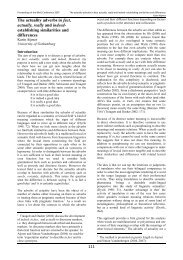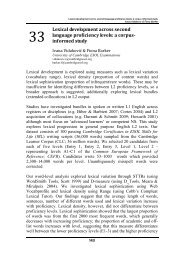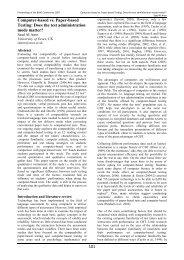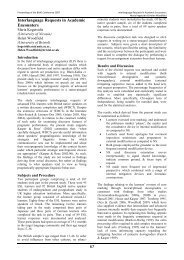Proceedings of the - British Association for Applied Linguistics
Proceedings of the - British Association for Applied Linguistics
Proceedings of the - British Association for Applied Linguistics
Create successful ePaper yourself
Turn your PDF publications into a flip-book with our unique Google optimized e-Paper software.
Accents <strong>of</strong> English and Listening Comprehension: Evidence <strong>of</strong> Conflict between ELT Handbooks and Teachers’ Practices<br />
Vasiliki Kanellou<br />
16<br />
Introduction<br />
Accents <strong>of</strong> English and Listening<br />
Comprehension: Evidence <strong>of</strong> Conflict<br />
between ELT Handbooks and Teachers’<br />
Practices<br />
Vasiliki Kanellou<br />
Cardiff University<br />
vikanellou@yahoo.com<br />
Listening to and processing <strong>the</strong> pronunciation <strong>of</strong> speakers <strong>of</strong> different<br />
native and no-native varieties <strong>of</strong> English presents a challenge <strong>for</strong> many<br />
learners; as Buck (2001: 35) puts it: “L2 listeners sometimes have<br />
considerable problems when <strong>the</strong>y hear a new accent <strong>for</strong> <strong>the</strong> first time… an<br />
unfamiliar accent can make comprehension almost impossible <strong>for</strong> <strong>the</strong><br />
listener”. Never<strong>the</strong>less, <strong>the</strong> existence <strong>of</strong> different regional varieties <strong>of</strong><br />
English in one country and <strong>the</strong> emergence <strong>of</strong> World Englishes create <strong>the</strong><br />
need <strong>for</strong> learners <strong>of</strong> English to be able to understand a wide variety <strong>of</strong><br />
accents. Thus, <strong>the</strong> general consensus among authors <strong>of</strong> recently published<br />
and currently used ELT handbooks (<strong>for</strong> example, see Celce-Murcia &<br />
Olshtain, 2001 or Harmer, 2007) is that accent is a very important variable<br />
in listening comprehension and exposure to different accents <strong>of</strong> English<br />
must be achieved through <strong>the</strong> listening element <strong>of</strong> any language course (<strong>for</strong><br />
fur<strong>the</strong>r in<strong>for</strong>mation, see Kanellou, 2009).<br />
Research Methodology<br />
In order to discover if EFL teachers share this view and if this is reflected<br />
in <strong>the</strong>ir teaching practices, a questionnaire was completed by a<br />
representative sample <strong>of</strong> 47 EFL teachers in Thessaloniki, Greece. One<br />
questionnaire question explored <strong>the</strong> extent to which teachers are aware <strong>of</strong><br />
<strong>the</strong> need to expose learners to various accents <strong>of</strong> English and ano<strong>the</strong>r<br />
question explored <strong>the</strong> extent to which such an exposure takes place in <strong>the</strong><br />
language classroom. The mean response <strong>for</strong> each questionnaire item was<br />
calculated and <strong>the</strong> paired-samples t-test was undertaken in order to<br />
determine if any differences in <strong>the</strong> scores were statistically significant.<br />
Interviews were conducted with 12 out <strong>of</strong> <strong>the</strong> 47 teachers that participated<br />
in <strong>the</strong> questionnaire survey in order to discuss <strong>the</strong> questionnaire results.<br />
83







